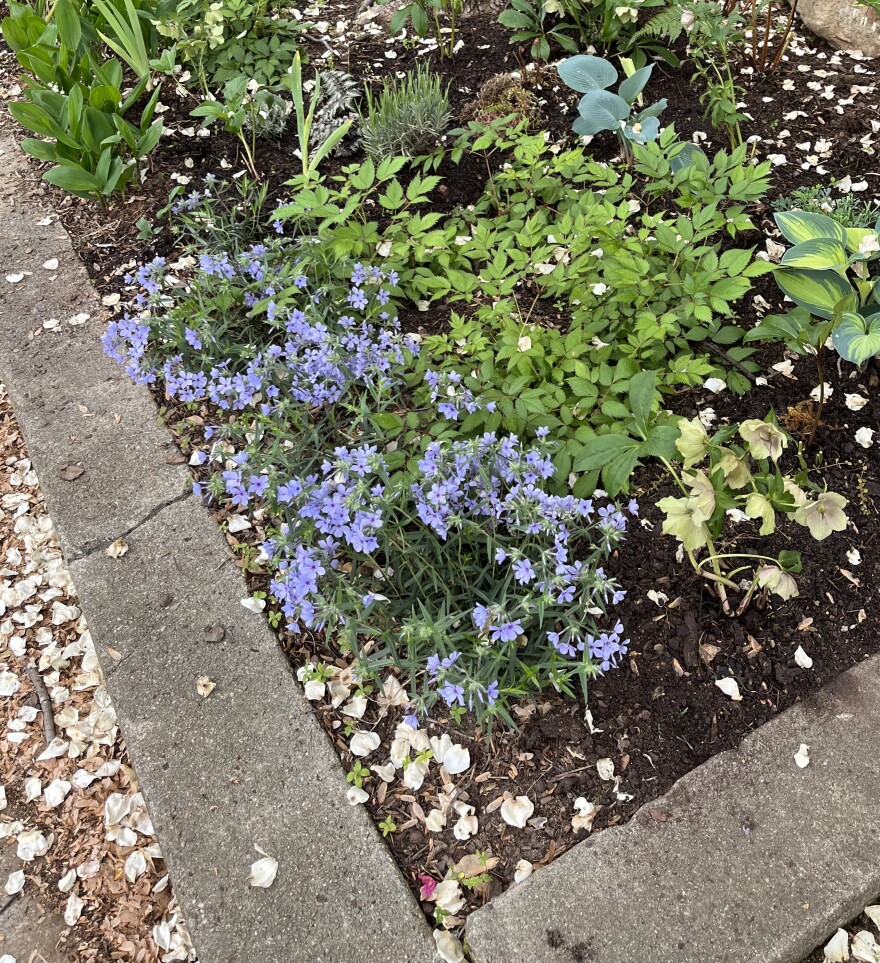A common question fellow gardeners ask me is about what my favorite plants are. While I have a few favorites, I really do like almost all plants so trying to choose just a few is difficult.
A genus of plants I enjoy growing is Amsonia spp. When I consult, I always recommend Blue Star Flower, Amsonia tabernaemontana or Arkansas Star Flower, Amsonia hubrichtii, to the point it has become a signature plant of mine. I love the sky-blue flowers and yellow to golden fall foliage these native plants add to a garden. They are drought resistant perennials which grow in sun or part shade reaching 3-4’ tall and wide.
The best part is the deer won’t touch them because they are in the same plant family as milkweed. What I want to share today are a few plants I find equally easy to grow as the Amsonias.
Designers know the color blue is a blending color; it compliments every color on the color wheel. The sky-blue of the Amsonia flowers is perfect for blending spring colors in the garden. However, there are times when a smaller plant is needed and that’s when I reach for the part shade-loving native, Phlox divaricata, or woodland phlox. Growing 12-15” tall, this mat-forming plant slowly spreads to create a sea of blue in the early spring. This adaptable perennial grows well in dry or clay soils once it is established. The flowers do well in a vase so pick a few to enjoy in the house!

Another sun to part shade ground cover is a true geranium, Geranium macrorrhizum, bigfoot geranium, which is native to Southern Europe. Our native Geranium maculatum, wild geranium, grows throughout the Piedmont and mountain regions of Virginia and other mid-Atlantic states.
Both geraniums make marvelous groundcovers and like the Woodland Phlox, are very adaptable to different growing conditions, except along the coast. Please don’t confuse these true geraniums with the large flowered, brightly colored “geraniums” sold at garden centers. Those plants are pelargoniums, not geraniums. Unfortunately, common names often confuse things.

Using plants to cover the soil surface is the best way to reduce the maintenance of a garden. Perennial groundcovers are great at this and so are flowering shrubs. I enjoy growing flowering shrubs and I admit to having a special affinity for hydrangeas. I like watching the transitions of the flowers between white and lime green of our native H. arborescens, smooth hydrangea. While 'Annabelle' and 'Incrediball' are great plants, this year I am adding the pink flowering H. a. 'Invincibelle® Spirit II' to my garden.
Another native hydrangea I grow is H. quercifolia, the oakleaf hydrangea. The straight species can grow quite large and a number of varieties like 'Alice' grow equally as large, often too large for a typical landscape. For smaller part-shade to shade gardens, I recommend H. q. 'Sikes Dwarf' and 'PeeWee', which grow only 3-4’ tall and wide.
While I am continually adding native plants to my garden there are many non-native plants I grow. That said, another hydrangea I am enamored with is H. paniculata, particularly the smaller varieties like 'Bobo' and 'Little Lime.' Still, the types which turn pink in the fall such as H. p. 'Vanilla Strawberry' makes the late season garden glow a bit brighter.

My garden is enjoyed by my neighbors, which includes the deer. Last year, I planted smaller flowering shrubs like Itea virginica 'Henry’s Garnet,' also known as Virginia Sweetspire, in large containers. I then placed the containers behind slightly smaller containers filled with annual Lantana camara varieties and other plants deer don’t browse like rosemary, Rosmarinus officinalis. I situated the pots in full sun against the house. I then mulched the exposed soil surface in each container to reduce watering and weeding.
With this arrangement, I was able to enjoy the shrubs all season long without the deer nibbling them down to stubs. To prevent the shrubs from becoming root-bound in their pots, I plan to lift each plant this month and prune the roots by removing about 40%. Afterward, I'll replant them in the same containers. This is an ideal task for March, as it allows the plants to grow new roots before summer.


While mid-March is the perfect time to sow tomato and pepper seeds indoors, it’s also a wonderful time to plant shrubs and perennials outside. So, let’s go shopping — plant shopping of course!
See you soon for a new season of Virginia Home Grown!
Peggy











